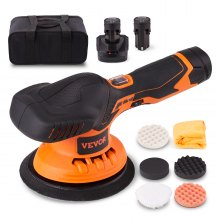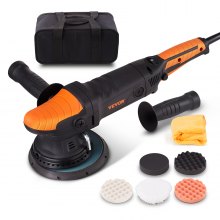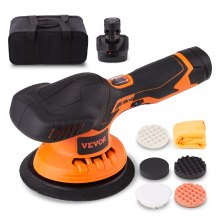Beyond Surface Beauty: The Benefits of VEVOR's Car Buffer Polishers
The first impression reigns supreme today. Therefore, surface beauty does not just portray you as vain. From meticulousness to carefulness, how your vehicle looks on your surface can communicate more about you than you think.
Imagine someone who wants to entrust you with a high-value property. However, they see that your high-end vehicle is scratched and dented. Trusting your management skills may be difficult because if you cannot keep your car tidy, how sure can you keep a high-value property in great shape?
Worry not, VEVOR, like many other times, has sorted this challenge for you. Our car buffer polishers are the answer.
Benefits of Car Buffer Polishers
Car buffer polishers have several benefits that make them essential tools for automobile hobbyists and professionals. From speed and precision to adaptability and cost-effectiveness, these new gadgets have altered the detailing process, allowing consumers to easily and confidently obtain professional-quality results.
Uniformity
Buffer polishers use double action or random orbital motion, which prevents holograms, buffer trails, and other surface imperfections commonly associated with rotary polishers. This uniform polishing action is smooth across the vehicle and ensures a finished overall appearance.
Professional Results
With advanced technology and precision, automotive buffer polishers deliver professional results that rival those achieved through professional detailing.
They can restore classic cars or make an average vehicle beautiful so users can get a showroom-quality finish with the car's aesthetic appeal and increased resale value.
Cost-Effectiveness
While advanced professional services can be expensive, investing in a high-quality automotive buffer polisher provides cost savings in the long run.
By doing DIY detailing in-house, enthusiasts can save money on labor costs and be satisfied with maintaining their vehicles to their exact standards.
Different Types Of Car Buffer Polishers
There are different vehicle buffer kinds to meet the varying demands and preferences of automobile enthusiasts and experts. Whether you need high-speed cutting power, precision control, or mobility, there's a buffer polisher type for every detailed need and skill set.
Understanding the distinctions between these categories is critical for choosing the best instrument to achieve the required goals efficiently and effectively.
Dual Action (DA) Polishers
Dual action polishers combine rotational and orbital motion and feature both rotational and oscillatory motion. Unlike rotary polishers, DA polishers move polishing pads in a random orbital arrangement, reducing the risk of swirl marks and holograms.
They are very user-friendly and intuitive, making them ideal for beginners and enthusiasts who want to improve their careers without extensive training.
Long-Throw DA Polishers
Long-throw DA polishers have larger orbit diameters, typically between 15 and 21 millimeters. The increased orbit size allows these polishers to cover a larger surface area with each pass, reducing polishing time and increasing workflow effectively.
Long-throw polishers are especially useful for large vehicles or professionals seeking maximum performance.
Battery Powered Polishers
Battery-powered systems make it easier to operate wirelessly, allowing users to wipe vehicles without plugging them into a power grid. They are suitable for mobile detailing or where power consumption is limited.
But battery-powered polishers can have shorter run times and slightly reduced power compared to their corded counterparts.
Polishing Techniques for Car Buffer Polishers
Different types of car buffer polishers require different techniques for optimal results. Here are techniques tailored to the main types of car buffer polishers: rotary polishers and dual-action (DA) polishers.
Rotary Polishers
Correcting Swirls And Scratches:
Start with a low to medium speed setting (usually between 1000 and 1500 RPM) to reduce the chance of burning through the paint. Properly eliminate flaws, use a cutting or polishing compound on a hard foam or wool pad.
Use little to moderate pressure on the polisher, allowing the weight of the machine to accomplish the majority of the job. Work in tiny parts, using the polisher gently and carefully in overlapping passes. Maintain a constant speed and angle to achieve even correction.
DA Polishers
Correcting Swirls And Scratches:
Start with a modest speed setting (often between 4000 and 6000 OPM) for cutting or fixing flaws. To achieve successful correction, use the DA polisher with a cutting or polishing compound and a medium-firm foam pad.
Use mild to moderate pressure, enabling the machine's dual-action motion to push the compound into the paint surface. Work in tiny parts, moving the polisher in overlapping passes at a steady speed and angle. The DA motion helps limit the likelihood of holograms or buffer trails.
Why Choose VEVOR Car Buffer Polishers?
With years of experience and a track record of customer satisfaction, VEVOR has earned a trustworthy reputation within the automotive care industry. Countless satisfied customers rely on VEVOR's products to meet their detailing needs, confident in the brand's commitment to quality and innovation.
Whether you are a seasoned professional or a DIY enthusiast, VEVOR's car buffer polishers enable you to achieve professional-quality results with minimal effort. The precision engineering and advanced features of VEVOR polishers ensure uniform polishing action, minimizing the risk of swirl marks, holograms, and other surface imperfections.
Prioritizing easy use and less complex setups, VEVOR’s car buffer polishes are easy to use and have intuitive controls and ergonomic handles. As such, we are also ensuring users’ convenience. With cutting-edge technology and premium quality, combined with a competitive price, VEVOR’s car buffers are the best for everyone.
FAQs About Car Buffer Polishers
How often should I polish my car with a buffer polisher?
The frequency of polishing depends on factors such as the quality of the paint job, driving habits, and environmental exposure. Generally, the vehicle needs to be polished 1-2 times a year for maintenance and protection. However, a typical or exposed car may need frequent polishing.
Can I use a car buffer polisher to remove scratches and swirl marks?
Yes, a car buffer polisher can effectively remove fine scratches, swirl marks, and other imperfections. However, deeper weaves may require additional procedures such as blending or wet sanding. It’s important to safely use the right polishing pads, polishing compounds, and methods to achieve the desired results.
Can I use any polishing compound with a car buffer polisher?
While many polishing chemicals are compatible with car buffer polishers, it is important to choose products that are specifically designed for a vehicle and are compatible with the type of polisher used. Using the wrong paint or abrasive tape can ruin the car’s image or produce unsatisfactory results.

























































































